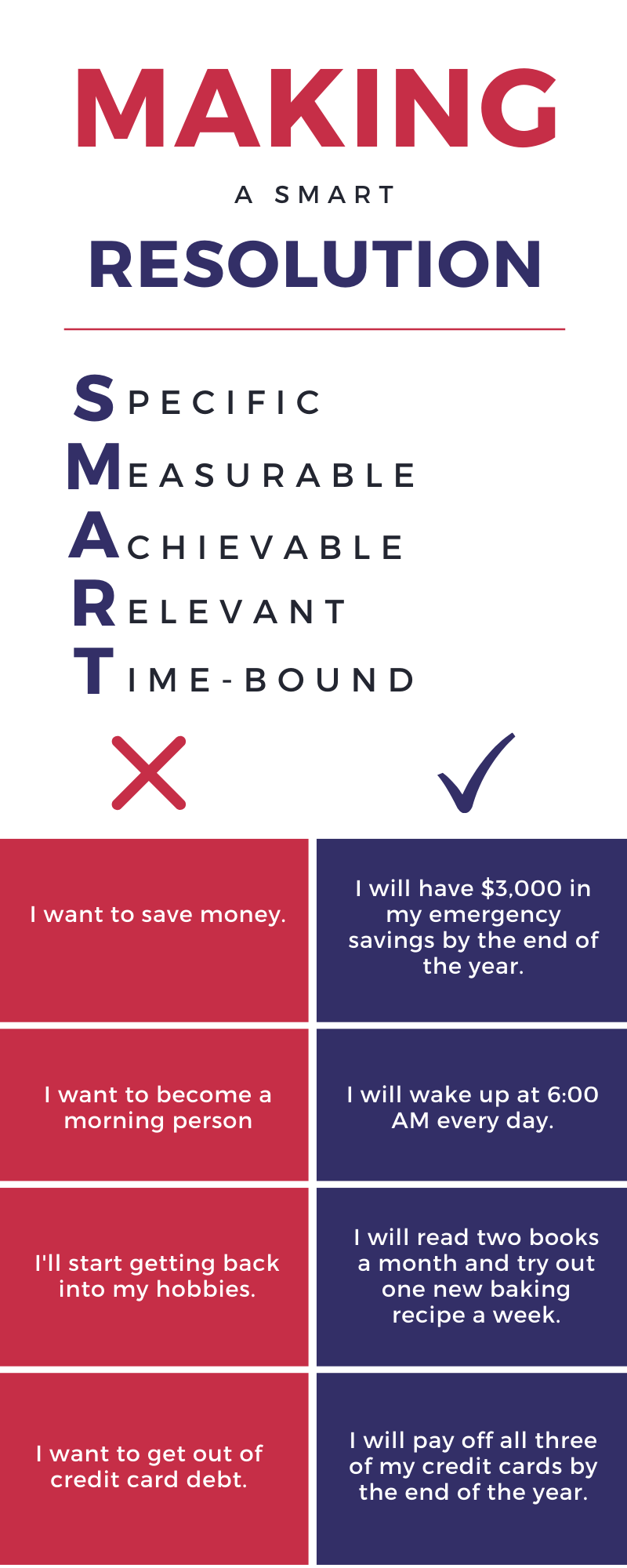How to turn your New Year's resolutions into actionable steps
It’s time again! Time to make resolutions, stick with them for about three weeks, and then forget about them until next year. Unfortunately, this is an all-too-common occurrence for most of us.
But why do New Year’s resolutions fail so often? We can chalk it up to three common factors:
The goals are too vague. You can’t achieve your goals if there is nothing tangible to work towards.
You don’t keep track of your progress. It is so easy to give up on your goal when it feels like you aren’t making any headway.
You don’t break the goals down into reasonable steps. When a project is monumental, it is natural to walk away because it seems impossible to achieve. For example, you can’t just sit down and write a novel, but you can sit down and brainstorm ten ideas for a novel.
Well, not anymore.
Now is the time you finally start completing your New Year’s resolutions. By putting in a little bit of work and planning upfront, you goals will be much easier to visualize and accomplish.
Keep reading for a step-by-step guide on creating tangible goals and breaking them down into small, doable steps.
Quick note: It does not have to be the new year for you to create goals and make changes in your life. You can do this whenever you want. Don’t wait for an arbitrary date to roll around to make the changes you want to see.
1. Create your goals and make them specific
The first step is to sit down and write out everything you want to accomplish in the next year. Your goals should be something you’re excited to bring in to your life. You should want to start on them immediately, not dread January 1st to roll around.
If you don’t even know where to begin, it might help to first think about how you want to feel by the end of next year. Do you want to be confident? Successful? Loved? Social? Productive? Pick the key words that drive you and go from there. For example, say you want to feel more productive. Well, what’s stopping you from feeling that way right now? Maybe you’re a night owl who wants to become a morning lark. Maybe you spend a lot of time on social media and want to cut down on screen-time. Whatever the case may be, the key words will help you find your goals.
Next, make sure your goals are SMART. What does that even mean? SMART goals were first developed in a business setting to help executives with their strategic planning. It has since become the standard for creating goals, whether in work or personal life.
A SMART goal is:
Specific. Your goal cannot be general and vague. You must have a very clear goal to reach for.
Measurable. You need to be able to keep track of your goal. This will help keep you motivated as you see progress, and it will help you make sure you’re on the right track.
Achievable. I dare you to dream big, but don’t go so big that you’re doomed to fail from the start. Don’t resolve to pay off your $40,000 student loan debt in one year when you are only making $30,000 in income a year.
Relevant. This goes back to your key words. If the goal isn’t getting you any closer to your values, it has no place being on your list.
Time-bound. Your goal must have a deadline. Having a deadline will motivate you to continue working to the end.
Your goals must be tangible and specific; this is the most important thing to remember when creating your resolutions. Vague goals are a surefire way to give up on your resolutions two weeks in because there is no end in sight. We naturally want a finish line, a light at the end of the tunnel, something that we can hold up at the end and say “I did it!”.
Let’s go through some common New Year’s resolutions and turn them into tangible goals:
I want to save more money. > I will save $3,000 into an emergency fund by the end of the year.
I want to become a morning person. > I will wake up at 6:00 AM every workday.
I want to start going to the gym > I will go to the gym four times a week and bench-press 200 pounds by the end of the year.
I want to declutter/get more organized > I will declutter my entire house by June and develop a strategy to stop impulse-buying needless items.
I want to learn piano > I will take piano lessons once a week and learn to play five songs by the end of the year.
I want to get back into my hobbies > I will read two books per month and try one new baking recipe a week.
I want to get out of debt > I will pay off the rest of my car note and pay off my Visa credit card by the end of the year.
2. Find a way to visualize your goals
Once you have your goals, finding a way to physically see them will help to keep your goals top-of-mind throughout the year. When you see your goals every day, you are encouraged to act on them.
The most popular way to do this is by creating a vision board. Now, I’m not about to try and tell you to stick a few pictures on a poster board and you’ll get everything you ever dreamed of. I know vision boards get a lot of flack because on the surface they can seem a little silly, but they do work. They work because they establish intention, remind you every day of your goals, act as a guiding light, and help you overcome any resistance you have. Vision boards are quite easy to make, and you can make it on a physical poster board or digitally using an app like Pinterest.
If vision boards aren’t your jam, keep it simple with a list of your resolutions. Write it on paper and stick it by your nightstand, put it in your notes app, or keep it in your planner. Put it wherever you will see it frequently.
However you decide to visualize your goals, just make sure they are somewhere else other than inside your head.
3. Reverse-engineer your goals
Now that you have your tangible goals in front of you, it is time to break them down into actionable steps. Some goals are simple. Say your resolution is to save $3,000 by the end of the year. You look at your budget and you decide that you can afford the extra $250/month, so you set up a recurring transfer to automatically deposit $250/month into your savings and you’re done.
A lot of times, goal may seem so big that you don’t even know where to begin. This is where breaking down the goal into steps becomes important. Begin by reverse-engineering the goal. Take your goal and break it into smaller and smaller chunks until you have a bunch of small steps.
A mind-map is a tool to break you out of the traditional liner thinking. When we try and jump straight into “step one, step two, step three…” we can get stuck, especially with long term goals and projects. A mind-map has one central idea with a bunch of branches coming out of it to break the idea down into smaller pieces. When creating a mind-map, don’t worry about the nitty-gritty details, just break the goal down into smaller steps and then break those steps down further, and so on until you’re confident that you have the full picture.
See our example of a mind-map:
Reverse-engineering your big resolutions will help make sure you don’t miss any steps, and will help you brainstorm multiple ways to get to your goal.
4. List your steps from start to finish
Now it’s finally time to list your steps. You can do this on paper or use a planning app like Trello. Make sure to give deadlines to the bigger milestones to help you stay on track.
Continuing with the example above, here is what a list of steps might look like:
Find out how much I will be paying in interest for my three cards over the next year (1/2)
Research consolidation loans with my local credit unions (1/8)
Contact the credit union with the best consolidation loan (1/10) - find out what I need to apply for the loan
Apply for the loan (1/13)
Meet with a financial counselor to adjust my budget to accommodate the new monthly payment (1/15)
Research side jobs to help make extra money (1/10)
Pick a job and go from there (1/15)
Set up an automatic payment on the loan (1/17)
Have monthly check-ins for my budget
Notice that all of these steps happen in January. That is because this goal requires a lot of upfront work upfront, but once her automatic payment is set up, the work is basically over. However, there are some tasks where you won’t know what the next step is when you make your list. For example, number six on our list has her researching side jobs and picking a side job. She won’t know what the next step is until she picks her job. That leads us to number five.
5. Sit down each month, week, and day and create a to-do list
As Gina Trapani says in this article, “when formulating a to-do, the onus is on your Boss self to make it as easy as possible for your Assistant self to get the job done.” This is what we are doing. We are taking time now to make it as easy for your future self to follow through with the goals that your present self has created.
At the beginning of each month, sit down and look at your goals and see what steps you can do from each project to get these goals done.
Do the same each week. Every Sunday, sit down and look at your to-dos for the month. What can you do that week to get everything done by the end of the month?
Finally, break this down into tasks to get done each day. By this time, you have essentially taken your big goal steps and broken them down into micro-tasks. These small steps lead to big change because you will be motivated to complete your to do list. It is so much easier to “call POECU and ask about their application process for their consolidation loan” than to “pay off all of my credit card debt.”
6. There’s nothing left to do but to do it!
By this point, you have taken your mountain of a goal and have broken it down into small, do-able steps. You’ve planned and planned, and now it’s time to put those thoughts into action!
Taking the first step towards your goal is always scary, but now you have a roadmap to guide you through. Remember to just focus on the next step and keep moving forward.
7. Make sure to track your progress
As you go through the year, keep track of your progress throughout your journey. Celebrate the big milestones and the journey. This will help keep you motivated when the progress you make is difficult to see.
Do whatever you can to track your progress so you can look back and see how far you’ve come. We suggest:
Taking photos
Starting a video diary
Keeping a journal
Making a graph
Set specific milestones
These will help you see how the small steps are adding up to major progress.
With your check ins, see if you are staying on schedule. Life happens, and we get knocked off course, but that’s okay! If you are able to get back on schedule, great! If you can’t, just adjust your timeline and keep working at it.
We make resolutions because we find joy in finding ways to challenge ourselves and make positive change in our life. Just remember: your resolutions should be goals that align with your values and bring you to a state that you desire.
Your resolutions should push and challenge you, but they should never make you unhappy. If you find yourself absolutely miserable when working on your resolution, step back and ask yourself why you even have the resolution in the first place. You may find you’ll be happier to get rid of it.
Our goals and ambitions drive us forward. That doesn’t mean they’re easy. But if you take the time to follow this guide and create your steps, your resolutions will change from a daydream to an actionable plan right before your eyes.
This is the year your life changes. You’ve got this.






